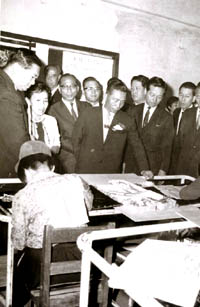| However, my career as a schoolteacher and an embroidery artist was suspended with my marriage. People would generally look askance at a woman of twenty-seven still remaining single in those days, and my parents were more than anxious for me to get married. My husband was a graduate of the Medical College of Kyung-sung Imperial University (now Seoul National University). I was ready to follow the ways that my mother and grandmother had trodden as the paragon of female virtues in the light of Confucianism since I had been taught the traditional womanhood from my childhood, I gave up my teaching as well as my embroidery to become devoted to my husband and his family.
I became a mother of four children, two boys and two girls. In the meantime, the end of World War II had brought us our liberation from Japanese, but there were still many difficulties and hardships we had to undergo along with the radical social changes. A great many people were suffering with poverty and the adversity. Nevertheless, I did not want my children to be hard up for money. My husband was the head doctor at the jail in Keasung, and his salary was hardly enough to support our family. I tried to earn more myself while keeping house for my family. To my regret work of embroidery had to be laid aside.
|
|
In 1949 our youngest child was born, and it was the same year that North Korean troops had invaded Keasung crossing over Mt. Songak.
We were so terrified that we moved to Seoul, taking our four children who were all different ages. Hardly were we settled down at the official residence in Mapo, where my husband had a new post as the head doctor in the Mapo jail when the Korean War broke out. We did not take refuge this time as my husband felt he should stay at his post, and we also thought that war would soon be over. The sufferings, troubles and threats to life that we had under the occupation of the North Korean troops were far more than I could describe. By the time the UN soldiers had restored Seoul, the Chinese troops marched down from the north. This time we took refuge in Pusan without delay.
Our refugee life in Pusan was not so hard as it had been in Seoul under the North Korean troops. We were fortunate to have some relatives and acquaintances who helped us out when we were in great need. Moreover, I was given the opportunity to get back to my embroidery that I missed so long, as well as to teach at the Home Economics Department of Ewha Womans College which had evacuated to Pusan during the war. After the war was over, we moved back to Seoul and found our residence at Ulchiro-4 Ka, and my husband managed to open the Oh Pediatric Hospital on the first floor of our house. I was happy to see our children growing fast, and on the other hand, my desire to go back to my embroidery began to increase soon after we settled down. |
 |
A turning point came in my life when I joined the International Society of Artists to travel all over Europe for six months to observe artwork in various countries. It was in 1961 when we were not allowed to travel abroad so freely as we are now, and I was very excited to step out into the open world and see those famous works of arts, which I had heard of and seen in books. I had my eyes wide open to see where I was, and I gained new strength and courage during the trip.
Returning home I immersed myself in my work of embroidery with a new confidence and enthusiasm. As a result I was able to have my first exhibition in 1962. It was a great success, and large crowds came each day. Many people complimented me, saying it was the first exhibition of fiber art in our part of the world and that I had opened up a new creative way in the history of embroidery. |
|


